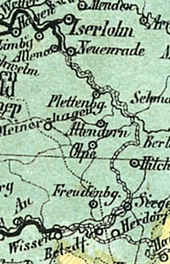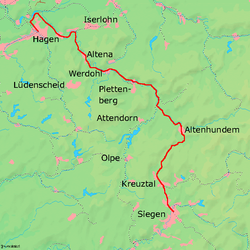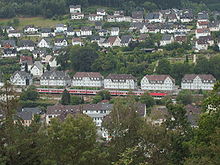Ruhr-Sieg route
| Ruhr-Sieg route | |||||||||||||||||||||||||||||||||||||||||||||||||||||||||||||||||||||||||||||||||||||||||||||||||||||||||||||||||||||||||||||||||||||||||||||||||||||||||||||||||||||||||||||||||||||||||||||||||||||||||||||||||||||||||||||||||||||||||||||||||||||||||||||||||||||||||||||||||||||||||||||||||||||||||||||||||||||||||||||||||||||||||||||||||||||||||||||||||||||||||||||||||||||||||||||||||||||||||||||||||||||||||
|---|---|---|---|---|---|---|---|---|---|---|---|---|---|---|---|---|---|---|---|---|---|---|---|---|---|---|---|---|---|---|---|---|---|---|---|---|---|---|---|---|---|---|---|---|---|---|---|---|---|---|---|---|---|---|---|---|---|---|---|---|---|---|---|---|---|---|---|---|---|---|---|---|---|---|---|---|---|---|---|---|---|---|---|---|---|---|---|---|---|---|---|---|---|---|---|---|---|---|---|---|---|---|---|---|---|---|---|---|---|---|---|---|---|---|---|---|---|---|---|---|---|---|---|---|---|---|---|---|---|---|---|---|---|---|---|---|---|---|---|---|---|---|---|---|---|---|---|---|---|---|---|---|---|---|---|---|---|---|---|---|---|---|---|---|---|---|---|---|---|---|---|---|---|---|---|---|---|---|---|---|---|---|---|---|---|---|---|---|---|---|---|---|---|---|---|---|---|---|---|---|---|---|---|---|---|---|---|---|---|---|---|---|---|---|---|---|---|---|---|---|---|---|---|---|---|---|---|---|---|---|---|---|---|---|---|---|---|---|---|---|---|---|---|---|---|---|---|---|---|---|---|---|---|---|---|---|---|---|---|---|---|---|---|---|---|---|---|---|---|---|---|---|---|---|---|---|---|---|---|---|---|---|---|---|---|---|---|---|---|---|---|---|---|---|---|---|---|---|---|---|---|---|---|---|---|---|---|---|---|---|---|---|---|---|---|---|---|---|---|---|---|---|---|---|---|---|---|---|---|---|---|---|---|---|---|---|---|---|---|---|---|---|---|---|---|---|---|---|---|---|---|---|---|---|---|---|---|---|---|---|---|---|---|---|---|---|---|---|---|---|---|---|---|---|---|---|---|---|---|---|---|---|---|---|---|---|---|---|---|---|---|---|---|---|---|---|---|---|---|---|---|---|---|---|---|---|---|---|---|
| Route number (DB) : | 2800 (Hagen – Siegen-Weidenau) 2880 (Siegen-Weidenau – Siegen) |
||||||||||||||||||||||||||||||||||||||||||||||||||||||||||||||||||||||||||||||||||||||||||||||||||||||||||||||||||||||||||||||||||||||||||||||||||||||||||||||||||||||||||||||||||||||||||||||||||||||||||||||||||||||||||||||||||||||||||||||||||||||||||||||||||||||||||||||||||||||||||||||||||||||||||||||||||||||||||||||||||||||||||||||||||||||||||||||||||||||||||||||||||||||||||||||||||||||||||||||||||||||||
| Course book section (DB) : | 440 | ||||||||||||||||||||||||||||||||||||||||||||||||||||||||||||||||||||||||||||||||||||||||||||||||||||||||||||||||||||||||||||||||||||||||||||||||||||||||||||||||||||||||||||||||||||||||||||||||||||||||||||||||||||||||||||||||||||||||||||||||||||||||||||||||||||||||||||||||||||||||||||||||||||||||||||||||||||||||||||||||||||||||||||||||||||||||||||||||||||||||||||||||||||||||||||||||||||||||||||||||||||||||
| Route length: | 106 km | ||||||||||||||||||||||||||||||||||||||||||||||||||||||||||||||||||||||||||||||||||||||||||||||||||||||||||||||||||||||||||||||||||||||||||||||||||||||||||||||||||||||||||||||||||||||||||||||||||||||||||||||||||||||||||||||||||||||||||||||||||||||||||||||||||||||||||||||||||||||||||||||||||||||||||||||||||||||||||||||||||||||||||||||||||||||||||||||||||||||||||||||||||||||||||||||||||||||||||||||||||||||||
| Gauge : | 1435 mm ( standard gauge ) | ||||||||||||||||||||||||||||||||||||||||||||||||||||||||||||||||||||||||||||||||||||||||||||||||||||||||||||||||||||||||||||||||||||||||||||||||||||||||||||||||||||||||||||||||||||||||||||||||||||||||||||||||||||||||||||||||||||||||||||||||||||||||||||||||||||||||||||||||||||||||||||||||||||||||||||||||||||||||||||||||||||||||||||||||||||||||||||||||||||||||||||||||||||||||||||||||||||||||||||||||||||||||
| Route class : | D4 | ||||||||||||||||||||||||||||||||||||||||||||||||||||||||||||||||||||||||||||||||||||||||||||||||||||||||||||||||||||||||||||||||||||||||||||||||||||||||||||||||||||||||||||||||||||||||||||||||||||||||||||||||||||||||||||||||||||||||||||||||||||||||||||||||||||||||||||||||||||||||||||||||||||||||||||||||||||||||||||||||||||||||||||||||||||||||||||||||||||||||||||||||||||||||||||||||||||||||||||||||||||||||
| Power system : | 15 kV 16.7 Hz ~ | ||||||||||||||||||||||||||||||||||||||||||||||||||||||||||||||||||||||||||||||||||||||||||||||||||||||||||||||||||||||||||||||||||||||||||||||||||||||||||||||||||||||||||||||||||||||||||||||||||||||||||||||||||||||||||||||||||||||||||||||||||||||||||||||||||||||||||||||||||||||||||||||||||||||||||||||||||||||||||||||||||||||||||||||||||||||||||||||||||||||||||||||||||||||||||||||||||||||||||||||||||||||||
| Top speed: | 120 km / h | ||||||||||||||||||||||||||||||||||||||||||||||||||||||||||||||||||||||||||||||||||||||||||||||||||||||||||||||||||||||||||||||||||||||||||||||||||||||||||||||||||||||||||||||||||||||||||||||||||||||||||||||||||||||||||||||||||||||||||||||||||||||||||||||||||||||||||||||||||||||||||||||||||||||||||||||||||||||||||||||||||||||||||||||||||||||||||||||||||||||||||||||||||||||||||||||||||||||||||||||||||||||||
| Dual track : | (continuous) | ||||||||||||||||||||||||||||||||||||||||||||||||||||||||||||||||||||||||||||||||||||||||||||||||||||||||||||||||||||||||||||||||||||||||||||||||||||||||||||||||||||||||||||||||||||||||||||||||||||||||||||||||||||||||||||||||||||||||||||||||||||||||||||||||||||||||||||||||||||||||||||||||||||||||||||||||||||||||||||||||||||||||||||||||||||||||||||||||||||||||||||||||||||||||||||||||||||||||||||||||||||||||
|
|||||||||||||||||||||||||||||||||||||||||||||||||||||||||||||||||||||||||||||||||||||||||||||||||||||||||||||||||||||||||||||||||||||||||||||||||||||||||||||||||||||||||||||||||||||||||||||||||||||||||||||||||||||||||||||||||||||||||||||||||||||||||||||||||||||||||||||||||||||||||||||||||||||||||||||||||||||||||||||||||||||||||||||||||||||||||||||||||||||||||||||||||||||||||||||||||||||||||||||||||||||||||
The Ruhr-Sieg line is a 106-kilometer, double-track , electrified main line from Hagen to Siegen via Iserlohn-Letmathe , Finnentrop and Kreuztal . The tunnel-rich route mainly leads through the Lenne valley and south of Lennestadt-Altenhundem over the watershed between the Ruhr and Sieg .
history
In 1835 the construction of a horse-drawn railway from Siegen to the Ruhr area was requested by a committee set up in Siegen specifically for this purpose. The aim was to be able to transport the coal from the Ruhr area cheaper and faster to the Siegerland for smelting. The iron production in Siegerland was very important for Prussia , because more than 23 percent of the total pig iron production and even 85 percent of the crude steel iron production of the state took place here.
After the approval process dragged on, in 1851 a main committee that had meanwhile been founded in Hagen applied for a steam train instead of a horse-drawn train. For a long time there was a dispute about where exactly the route should come from. Initially, a route from Hagen through the Volmetal was favored, only later the line through the Lenne and Hundem valley was preferred. An interest group from Olpe wanted to connect Olpe to the main route through the Biggetal , the two committees in Siegen and Hagen decided on the eastern route through the Hundemtal because this was the shorter and therefore cheaper. The highest point of the railway line is in Welschen Ennest with a height of almost 411 meters.
The construction was finally approved in 1856 with a state interest guarantee. Because the huts along the route in particular promised economic growth, they partly participated in the financing, for example the Meggenerwerk and the Würdinghauserhütte with 1000 thalers each, the Carolinenhütte with 5000 thalers and finally the Kirchhundem community with 2100 thalers. The hoped-for upswing did not take place at first, however, as mainly charcoal was brought from the Sauerland to the Siegerland and the cheaper hard coal could now be used.
Track construction

The construction of the line took place from 1858 to 1861 under the direction of the Bergisch-Märkische Eisenbahn-Gesellschaft and caused some problems. The Austrian engineer Franz von Rziha , who had already worked on the construction of the Semmering Railway, was involved in the construction of the tunnels . As narrow valleys had to be crossed, the Borsig company built a special locomotive called the 675 series , which was also designed for curves. Initially, the line was single-track, but was expanded to double-track as early as 1870.
The section from Hagen to Letmathe was opened on March 21, 1859, the section from Letmathe to Altena on July 17, 1860 and finally the last section from Altena to Siegen on August 6, 1861. Before that, on August 5, 1861, the Ruhr-Sieg took place -The railway has been inaugurated. A pageant used for this derailed in Grevenbrück, but without any injuries to complain.
Railway stations were built in all larger towns, with the Tudor- style railway stations in Plettenberg, Grevenbrück and Kreuztal being atypical for the region (today they are architectural monuments). Locomotive sheds with turntables have existed in Letmathe (for two locomotives), Altena (Westf) (six locomotives), Lennestadt-Altenhundem (six locomotives), Kreuztal (two locomotives) and Siegen (nine locomotives) since it was commissioned. The Finnentrop depot was not established until the end of the 1870s in connection with the branch lines to Olpe and Wennemen. Together with Lennestadt-Altenhundem, it gradually developed into one of the operating centers of the Ruhr-Sieg route. Lennestadt-Altenhundem was primarily the place of use of the heavy freight locomotives for the pushing operation on the ramps to the breaking point in Welschen-Ennest. The depots in Letmathe and Kreuztal lost their importance due to their proximity to the large depots in Hagen and Siegen. Altena was given up at the beginning of the 20th century. In the course of electrification, Lennestadt-Altenhundem was given up and Finnentrop was greatly reduced. Today only the railcars used on the route to Olpe stay here.
Change of course book number
Until the revision of the timetable number system in 1992, as a result of reunification, the connection from Hagen was run as a continuous route to Giessen under the name "Kursbuchlinie 360". In Siegen-Weidenau there was a connection to Siegen and to the victory route (KBS 460) to Cologne.
Since the introduction of the integral cycle timetable ( NRW cycle ) in 1998, all local passenger trains have been running via Siegen, mostly with reciprocal connections. From this point in time at the latest, a designation for a continuous connection to Giessen would have been inexpedient. The section from Siegen via Dillenburg and Wetzlar to Gießen is now known as the Dill route (KBS 445).
Long-distance passenger rail transport
Around 1980, through express trains ran from Norddeich Mole over the Ruhr-Sieg route as well as Frankfurt (Main) and Stuttgart to Munich . There was also a through car run from Norddeich Mole to Friedrichshafen over the Ruhr-Sieg route. Express train stops were in Hagen, Iserlohn-Letmathe , Altena , Finnentrop , Altenhundem, Kreuztal and Hüttental-Weidenau (now renamed Siegen-Weidenau). Since the operation of Hagen Hbf meant a time-consuming branch trip and a change of direction, the Volmestadt was sometimes connected with a train section that was shunted to the main train from Norddeich in Iserlohn-Letmathe. This had previously driven the connecting curve from Hamm .
The fast connection Mon – Fri with D 810/811 was just an interlude, connecting Dortmund with Frankfurt in a travel time of less than three hours, only stopped in Siegen-Weidenau and Wetzlar en route and made up of high-quality cars that were otherwise only run on intercity trains was. This was faster than via Koblenz and along the Rhine. Since it depended on the resourcefulness of the course book reader to see this connection, which was primarily designed for business travelers, it was soon discontinued.
After long-distance passenger rail transport was switched from express trains to interregional trains in 1993, these only stopped regularly in Hagen, Werdohl, Finnentrop, Lennestadt-Altenhundem and Siegen-Weidenau. Long-distance passenger rail transport with several pairs of express trains daily and later an interregional line from Münster (from summer 1999 Düsseldorf) to Frankfurt was discontinued for the 2001 summer timetable, the pair of trains between Norddeich Mole and Frankfurt, which was only offered once a day, was discontinued a year later. Since then this route has been without long-distance traffic.
On March 18, 2015, Deutsche Bahn (DB) announced in a press release that it would expand its long-distance transport offer by 25 percent. The Dill route and the Ruhr-Sieg route should also benefit from this. DB originally planned to set up an intercity line from Frankfurt via Siegen and Iserlohn-Letmathe to Dortmund and Münster from the 2019/2020 timetable change, and operations are currently expected to start in December 2021. This line is to run every two hours with new double-decker intercity wagons ( Bombardier Twindexx ) and a corresponding electric locomotive.
In 2015, DB Fernverkehr approached the local transport authorities and made it clear that the long-distance line could not be implemented without adjustments in local transport. Shortly afterwards, DB Fernverkehr and the Zweckverband Nahverkehr Westfalen-Lippe entered into negotiations about the integration of the Intercity line into the local traffic cycle. To this end, the long-distance line is to replace the RE 16 line between Iserlohn-Letmathe and Siegen with almost all of its intermediate stops every two hours. Only Kirchhundem should be passed through by the IC without stopping and would therefore lose a train every two hours in Welschen-Ennest. At the junction in Hagen-Kabel, the new line is to continue directly towards Schwerte and Hagen-Vorhalle via the two connecting curves and thus not stop at Hagen Hauptbahnhof. In addition, DB Fernverkehr is to receive compensation payments for the recognition of local transport tickets.
Operational peculiarities
Even today, heavy goods trains are pushed south between Lennestadt-Altenhundem and Welschen Ennest with an additional locomotive . This then drives back to Lennestadt-Altenhundem. The gradient is only 12 ‰, but it is very long and winding. Frequent speed changes are therefore necessary. Before the electrification of the Ruhr-Sieg line, almost all freight trains were pushed to Welschen Ennest. Freight trains from Kreuztal to Welschen Ennest have rarely had this support.
In Iserlohn-Letmathe station, the regional express and regional trains from Iserlohn and Siegen are merged and run as a unit via Hagen, Witten and Bochum to Essen, with the regional trains already ending in Hagen. In the opposite direction, the trains are separated at Iserlohn-Letmathe station and then run separately to Siegen and Iserlohn.
Since the discontinuation of the Frankfurt - Münster (- Norddeich Mole) interregional line, the double-track Giersberg tunnel in Siegen, which connects the Ruhr-Sieg route with the Dill route and enables the bypassing of Siegen main station, has only been used for freight traffic. The entire connecting route from Siegen-Weidenau to Siegen Ost, including the turnouts, can be driven continuously in both directions at 80 km / h. Using further connecting curves and branches in the area of Hagen-Kabel and Hohensyburg, freight trains can run between Gießen and the Ruhr area without changing direction and bypassing Hagen main station. This connection was also used by the D 810/811.
Expansion measures
The Ruhr-Sieg route as part of the Hagen - Hanau route is listed as an upgraded route (ABS) in the Federal Transport Infrastructure Plan 2030 . A summarized measure “Corridor Middle Rhine: Target Network I” is included under the item “New projects, urgent need”. This includes u. a. Block compaction between Kreuztal and Siegen as well as the production of the KV-Profil P / C 400 at all tunnels between Hagen and Siegen to relocate parts of the container freight traffic from the Rhine routes to the Ruhr-Sieg route. The flattening of the steep Lennestadt-Altenhundem-Welschen Ennest stretch was not included in the new Federal Transport Infrastructure Plan 2030. In recent years, route renovation measures have been taken (e.g. renewal of the level crossings ), large sections of the route have been converted to electronic interlocking technology (reasons for rationalization) and the following measures have been taken, such as switch and track renewal, overhead line renewal and signal renewal. In addition, almost all train stations from Altena to Siegen-Weidenau have been converted to be handicapped accessible by the modernization offensive of the state of North Rhine Westphalia (MOF). In the station Finnentrop was for this reason, in December 2007 reception building demolished. A new, platform-level train-bus link was created there.
In future, after the MOF has been carried out, the name of the municipality in which it is located will be added to every modernized train station (e.g. Littfeld zu Kreuztal-Littfeld ). This is also done retrospectively with other train stations.
Timetable offer
The Ruhr-Sieg route is served hourly by local rail passenger transport.
- from the Regional-Express RE 16 ( Ruhr-Sieg-Express ) with a connection to Essen and
- from the regional train RB 91 (Ruhr-Sieg-Bahn).
All trains that start their journey after 8 p.m. travel as RB 91 and stop at all stations. The only exception is the train every day at 8:15 p.m. from Hagen main station. It operates as RE 16 because it is tied up by food. But he also serves all stations up to Siegen. At the end of the day, individual journeys of the RB 91 with the Siegen-Finnentrop train route are carried out by the Hessian State Railway.
A special regulation at the weekend applied in the period from the 2007/2008 timetable change to the change in December 2013. The RB 91 rides were canceled on Saturdays from 4pm or 5pm to 8pm and all day on Sundays and public holidays until 8pm, instead they stopped on Saturdays and Sundays the RE 16 every two hours alternately at the stations Meggen or Kirchhundem and Littfeld or Eichen. This regulation meant that the four stations were served more frequently on Saturdays than on all other days.
Local rail passenger transport has been carried out since December 9, 2007 by Abellio Rail NRW , which uses two- and three-part FLIRT electric multiple units on both lines . Previously, the trains consisted of one or two electric multiple units of the DB series 425/435 and 426 ("Ruhr-Sieg-Express") or push- pull trains of four n-wagons with push / pull locomotives of the DB series 143 ("Ruhr- Sieg-Bahn ") of the DB Regio NRW .
Before the timetable change, there was next to the lines RE 16 and RB 91 also the RB 56, which drove from Hagen to Iserlohn, as the RE 16 and the RB 91 only went to Siegen before 2008. The trains on this line mostly consisted of a class 143 locomotive and a single double-decker control car . The RB 56 was replaced by the wings of the RE 16 and the RB 91.
The Ruhr-Sieg route is also used by local rail freight traffic. There are important sidings in Kreuztal and Siegen-Weidenau, both of which are operated by the Siegen-Wittgenstein district railway.
See also
literature
- Rolf Löttgers: Ruhr victory: A railway line is being electrified . In: Alfred B. Gottwaldt (ed.): Lok magazine . No. 116 . Franckh'sche Verlagshandlung, W. Keller & Co. , 1982, ISSN 0458-1822 , p. 369-383 .
- Martin Vormberg: The Ruhr-Sieg Railway. In: Alfred Bruns (Red.): The railway in the Sauerland. Schmallenberg 1989, ISBN 3-922659-63-2 , p. 41 ff.
- Dieter Tröps, Jürgen Kalitzki: People, Trains, Railway Stations - Volume 1: Railways in the Sauerland. The Ruhr-Sieg route with the railway locations Altenhundem, Grevenbrück, Meggen, Kirchhundem and Finnentrop. Siegen 1995, ISBN 3-923483-20-1 .
- Dieter Tröps, Jürgen Kalitzki: People, Trains, Railway Stations - Volume 2: Railways in Siegerland. The Ruhr-Sieg route with the railway locations Siegen, Weidenau, Kreuztal, Hilchenbach, Betzdorf, Freudenberg and Olpe in the Sauerland. Siegen 1996, ISBN 3-923483-22-8 .
- Dietmar Simon: The long way to the Ruhr-Sieg Railway. A dispute over regional transport policy in the 19th century. In: Der Märker Heft 3, 1996, p. 187 ff.
- Konrad Fuchs: The development of the Siegerland by the railroad (1840-1917) . Wiesbaden 1974, ISBN 3-515-01948-0 .
- Bernd Franco Hoffmann: The Bergisch-Märkische Eisenbahn. Through the valleys of Wupper, Ruhr and Volme Sutton-Verlag, Erfurt 2015, ISBN 978-3-95400-580-2 .
Web links
NRWbahnarchiv by André Joost:
- Route 2800 : Hagen Hbf ↔ Siegen-Weidenau
- Route 2880 : Siegen-Weidenau ↔ Siegen Hbf
further evidence:
- Location and course of the route on the OpenRailwayMap
- Wolf-Dieter Grün: The construction of the Ruhr-Sieg route 140 years ago. In: To Bigge, Lenne and Fretter , Finnentrop 2001, issue 13 a. 14 (PDF; 1.7 MB)
- Construction facilities of the Ruhr-Sieg Railway. , Düsseldorf 1864
- Cultural region of South Westphalia: A traffic route as a cultural landscape characteristic .
Individual evidence
- ↑ https://www.eisenbahn-tunnelportale.de/lb/inhalt/tunnelportale/2800-hofolpe.html Pictures of the removal of the tunnel
- ↑ DB Netze - Infrastructure Register
- ↑ Railway Atlas Germany . 9th edition. Schweers + Wall, Aachen 2014, ISBN 978-3-89494-145-1 .
- ^ Siegerländer Heimatkalender from 1969, "Milestones from the Siegerland Past" by Adolf Müller, p. 112, Verlag für Heimatliteratur
- ↑ More rail for metropolises and regions: The largest customer offensive in the history of DB long-distance transport ( Memento from March 20, 2015 in the Internet Archive ). Press release from March 18, 2015.
- ↑ Zweckverband Nahverkehr Westfalen-Lippe, 36th Association Assembly, Item 8: Planning of the DB Long- Distance Transport in the Corridor Frankfurt - Siegen -Dortmund / Unna - Münster (zip file)



